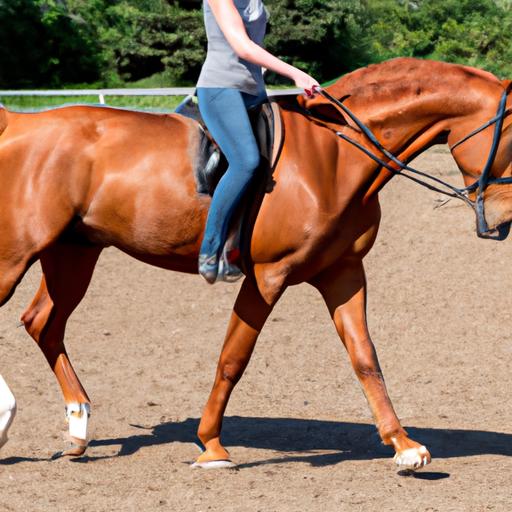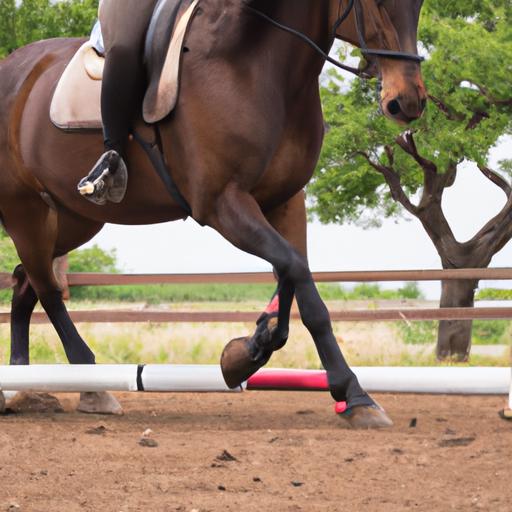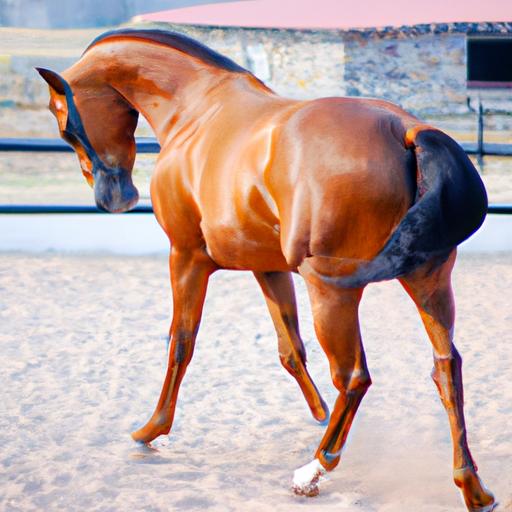Unlock the grace and power of your horse with cadence horse training. Discover the concept, factors, and benefits of developing cadence for equine excellence.
Introduction

When it comes to horse training, one concept that reigns supreme is cadence. Cadence refers to the rhythmic and harmonious movement of a horse, where every stride exudes grace and power. It is the magical synchrony between horse and rider that leaves spectators in awe and competitors envious. But what exactly is cadence, and why is it so crucial in horse training?
Defining Cadence
Cadence, in the realm of horse training, encompasses the fluidity, balance, and rhythm of a horse’s movement. It is the symphony of strides that showcases a horse’s natural grace and athletic ability. Picture a horse effortlessly gliding through a dressage test, each step carefully calculated, and every movement captivating to behold. That is the essence of cadence.
The Importance of Cadence
Cadence is not merely a superficial attribute; it is a fundamental aspect of horse training that directly impacts performance and overall well-being. A horse with well-developed cadence moves with efficiency, balance, and grace, reducing the risk of injury and enhancing their athletic capabilities. Moreover, cadence contributes to the horse’s mental and emotional well-being, as they find harmony and confidence in their movements.
The SEO Advantage in Cadence Horse Training Articles

Now that we understand the significance of cadence in horse training, let’s explore another crucial aspect: an SEO-optimized approach to writing about cadence horse training. In today’s digital age, where information is just a click away, it is vital to employ strategies that allow your content to stand out amidst the sea of articles.
The Power of SEO-Optimized Content
By optimizing your cadence horse training articles for search engines, you can ensure that your valuable insights and expertise reach the right audience. Utilizing relevant keywords, including our main keyword “cadence horse training,” strategically throughout the article will increase your chances of ranking higher in search engine results pages (SERPs). This, in turn, drives organic traffic to your website and establishes your authority in the field.
Connecting with Horse Enthusiasts Worldwide
Imagine your article being the guiding light for aspiring equestrians seeking to develop their horse’s cadence. By applying SEO techniques, you can make your content discoverable to horse lovers across the globe. From novice riders searching for foundational information to experienced trainers seeking advanced techniques, your article can be the go-to resource they’ve been yearning for.
In the next section, we will delve deeper into understanding cadence in horse training, exploring the concept itself and the factors that influence its development. Join me on this journey to unlock the secrets of cadence and witness the transformative power it holds.
Understanding Cadence in Horse Training
Explaining the Concept of Cadence in Horse Movements
Cadence is more than just a fancy term; it embodies the very essence of a horse’s movement. It refers to the rhythmic and harmonious flow of each stride, where the horse exhibits balance, impulsion, and elasticity. Picture a horse effortlessly floating through the air during a dressage test or gracefully navigating an intricate show jumping course. That is the embodiment of cadence.
Factors Influencing Cadence in Horse Training
Numerous factors contribute to the development and refinement of a horse’s cadence. First and foremost is the horse’s conformation, which dictates their natural ability to engage their hindquarters and carry themselves in balance. Additionally, the horse’s temperament, athleticism, and overall training play significant roles in their ability to achieve and maintain cadence. A harmonious partnership between horse and rider, built on trust and communication, is essential in unlocking the full potential of cadence.
Benefits of Developing Cadence in Horses
The benefits of developing cadence in horses extend far beyond mere aesthetics. A horse with well-established cadence moves with grace, efficiency, and power, reducing the risk of injuries caused by unbalanced movements. Furthermore, cadence enhances the horse’s overall athleticism and performance, allowing them to execute complex movements and transitions with ease. Developing cadence also improves the horse’s mental well-being, as they find confidence and harmony in their movements, leading to a happier and more willing equine partner.
In the next section, we will explore techniques and exercises that can aid in the development of cadence in horse training. By implementing these strategies, you can unlock your horse’s full potential and witness them move with the grace and elegance that cadence entails.
Training Programs for Cadence Horse Training
A. Designing a Structured Training Program for Cadence Development
To embark on the journey of developing cadence in your horse, it is crucial to establish a structured training program. This program acts as a roadmap, guiding you and your equine partner towards achieving the desired harmony and rhythm in their movements. Start by assessing your horse’s current level of cadence and identifying areas that need improvement. Then, create a customized plan that includes a blend of exercises targeting balance, suppleness, and coordination.
B. Incorporating Interval Training Techniques to Improve Cadence
Interval training is a powerful tool for enhancing cadence in horses. By alternating between periods of intense work and active recovery, you can challenge your horse’s cardiovascular system and promote muscle development. Integrate short bursts of collected, engaged work with moments of relaxation and stretching. This variation in intensity will encourage your horse to engage their hindquarters, thus improving their overall cadence and balance.
C. Balancing Flatwork and Jumping Exercises for Optimal Cadence Development
Incorporating a balance between flatwork and jumping exercises is essential for developing optimal cadence in your horse. Flatwork exercises such as circles, lateral movements, and transitions help improve suppleness, collection, and overall body control. These foundational skills lay the groundwork for a horse to perform with cadence and precision. Additionally, integrating jumping exercises adds an element of excitement and challenge, further refining your horse’s athleticism and coordination.
Remember to tailor the training program to your horse’s individual needs and progress gradually. Consistency, patience, and positive reinforcement are key components of successful cadence development. In the next section, we will explore the common challenges faced during cadence horse training and discover effective solutions to overcome them. Let’s navigate through these hurdles together and uncover the path to unlocking your horse’s true potential.
Common Challenges in Cadence Horse Training and Solutions
Cadence horse training comes with its fair share of challenges, but fear not! With a little understanding and the right strategies, you can overcome these obstacles and bring out the best in your equine partner. Let’s explore some common challenges in cadence horse training and discover effective solutions to tackle them head-on.
A. Addressing Stiffness and Lack of Flexibility in Horses
Stiffness and lack of flexibility can hinder a horse’s ability to achieve optimal cadence. When a horse’s muscles and joints are tight, their movements become restricted, leading to a loss of fluidity and rhythm. So, how can we address this challenge?
1. Stretching and Flexibility Exercises
Incorporating stretching and flexibility exercises into your horse’s training routine can do wonders in combating stiffness. Gentle stretches, such as carrot stretches, can help loosen tight muscles, while exercises like leg yields and shoulder-in encourage suppleness and increased range of motion.
2. Massage and Bodywork
Consider seeking the assistance of a professional equine massage therapist or bodyworker. These experts can identify areas of tension and provide targeted treatments to release muscle knots and promote overall relaxation. Regular sessions can significantly improve your horse’s flexibility and ultimately enhance their cadence.
B. Overcoming Resistance and Resistance-Related Issues in Cadence Training
Resistance can manifest in various forms during cadence training, hindering progress and causing frustration for both horse and rider. Let’s explore some effective strategies to overcome resistance and resistance-related issues.
1. Establish Trust and Confidence
Building a strong bond based on trust and clear communication is essential to overcome resistance. Spend time on groundwork and establish a foundation of mutual respect. By creating a safe and positive training environment, you can help your horse feel secure and willing to engage in cadence training.
2. Break It Down and Gradually Build Up
If your horse shows resistance to specific exercises or movements, break them down into smaller, more manageable steps. Gradually build up the difficulty level while rewarding even the smallest efforts. By taking a patient and progressive approach, you can overcome resistance and gradually improve your horse’s cadence.
C. Dealing with Irregular or Uneven Strides during Cadence Training
Irregular or uneven strides can disrupt the harmony and rhythm required for cadence. However, with proper understanding and training techniques, you can address this challenge effectively.
1. Corrective Exercises
Work with a knowledgeable trainer or instructor who can identify the root cause of your horse’s irregular or uneven strides. They can recommend specific corrective exercises tailored to your horse’s needs. Exercises such as trot poles or raised cavaletti can help improve stride regularity, encouraging your horse to find their natural cadence.
2. Regular Evaluation and Adjustments
Monitor your horse’s progress closely and be open to making necessary adjustments in your training program. Regular evaluations, either through video analysis or in-person observations, can help identify areas that need improvement. By addressing any irregularities promptly and adjusting your approach, you can guide your horse towards achieving a consistent and harmonious cadence.
With these solutions in your training toolbox, you can confidently navigate through the challenges that arise during cadence horse training. In the next section, we will explore various training programs designed to enhance cadence and further refine your horse’s rhythmic movements. Stay tuned!


